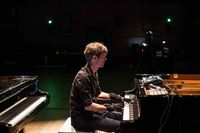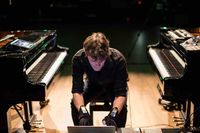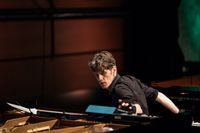PYANOOK reinvents the grand piano in the digital age ➚
Visionary pianist and composer Ralf Schmid unites instrumental virtuosity with futuristic electronic sound creation. He performs on two pianos (beauty and beast) with mi.mu data gloves and catapults the ever-auratic piano into the 21st century. PYANOOK interweaves the natural piano tone with motion-controlled electronics to an exquisite, redefined piano sound spectrum. His music oscillates between pulsating grooves, dense harmonies and timeless pianistic poetry.
About PYANOOK. The blend of analogue and digital sounds is no new feat in modern compositions, but few artists have taken this musical symbiosis as broadly and deeply as the pianist Ralf Schmid in his newest project, PYANOOK. While technology is often employed in acoustic pieces on a post-production level, to modify or add layers to existing sounds, Schmid employs it from the inception – at the composition and performance of his pieces. To do so, he turned to a special and groundbreaking piece of music technology, the mi.mu gloves, which allow him to digitally manipulate the sound of what he plays on the piano instantly by his hand gestures only. This live interaction of instrumental virtuosity and technology didn’t just result in an album, but also in a much wider project and direction for Schmid giving birth to the pianists’ new persona and alias, PYANOOK. “PYANOOK is my artistic exploration of technology. I set myself just one limit: all electronic sound creation is based on the timeless timbre of the grand piano,” says Schmid of the project.
Introduced by the renowned British musician, Imogen Heap, the musical gloves are pieces of wearable tech that connect movement to sound by using sensors that convert different hand gestures into programmable sound effects. The gloves allow musicians to create music in a more natural and expressive way, “Here's an example: I want to send the piano sound into a big reverb – not just turning it on and off but rather fade the effect in and out. I combine this fade with a glove movement, i.e. an opening gesture moving both hands to the side and opening my arms,” explains Schmid. The German composer had already worked with digital tools in the past, but it was at an artist residency in Oslo that he dug deep into how he could use technology to widen the palate of his own instrument, the grand piano. It turned out that the gloves fit like a glove.
With PYANOOK, Schmid unlocks whole new potentials for analogue instruments and live performances. Bringing the album to stage isn’t just a matter of reading a score and playing - the compositions come to life with every movement of the pianist, becoming intrinsically and physically connected to him. Every slight turn of the wrist, every bend of a finger alters the sound emanating from the piano in unique ways, “While experimenting with keys and gloves, there was a moment when I stood up from the piano bench to extend my radius. I triggered piano chords with ‘drum-hits’ in the air, opened effect spaces with arm movements and conducted the electronic sound flow,” says Schmid. Added to his intense performance which sees him move his entire upper body in a rhythmic display, is a mesmerizing lighting show and visuals by Pietro Cardarelli. Triggered by the gloves’ movements, Schmid and Cardarelli interact audiovisually in real time.
The search for the essence of sound and the exploration of its limitless possibilities has animated much of Ralf Schmid’s earlier work. He has worked with wildly diverse artists such as Herbie Hancock, Whitney Houston or Daniel Hope, directed large ensembles and choirs, and collaborated with trumpeter Joo Kraus to produce albums which are a true testament to his openness towards music. With PYANOOK, Ralf Schmid opens up the piano itself and sets free its soul and potential.“ I discover magic, choreography, poetry in the interaction of humans and Machine. ”PYANOOK marks a new chapter on an ongoing voyage that doesn’t seem to be halting anytime soon, “It’s a futuristic way to play an instrument of large tradition. It's the travelogue of my ongoing grand piano expedition,” he says,” There are so many sound possibilities left ‘on the way’, so many discoveries of new performances developed while performing, so many recommendations for new exciting tools. I feel this work has just started and deserves more exploration.”
.jpg/picture-200?_=17b0d974a80)
.jpg/picture-200?_=17b0d966020)
.jpg/picture-200?_=17b0d972b40)


